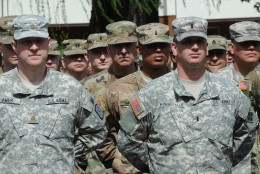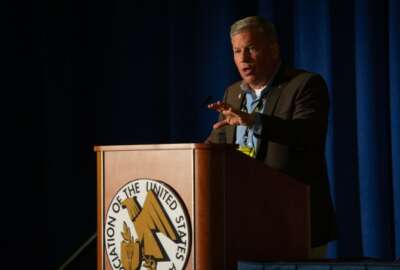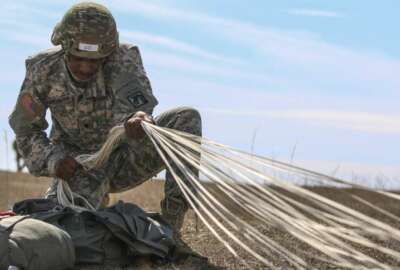
Army has to adapt to the growing battle of urban warfare
Conflict, instability and political unrest have all become more urban. Some say the Army has not adapted nearly enough to the demands of urban warfare.
Best listening experience is on Chrome, Firefox or Safari. Subscribe to Federal Drive’s daily audio interviews on Apple Podcasts or PodcastOne.
Conflict, instability and political unrest have all become more urban. Some say the Army has not adapted nearly enough to the demands of urban warfare. Even though Army leadership has acknowledged this need. For more, Federal Drive with Tom Temin turned to the chief of urban warfare studies at West Point, John Spencer.
Interview transcript:
Tom Temin: Mr. Spencer, good to have you on.
John Spencer: Thanks a lot. I really appreciate it.
Tom Temin: And we should point out that as a veteran of urban warfare, you know where of you speak. This is not purely an academic question for you, is it?
John Spencer: No. And actually that kind of drove me into my deep passion for the topic was experiencing it firsthand, both in 2003 for the invasion of Iraq, and then really when I was deployed in 2008 into Baghdad, a really dense urban area.
Tom Temin: Given the last 24 years of military experience that the United States has had, 20 some years of all the armed services, and the fact that we’ve had what five quadrennial Defense reviews in that period, a whole new doctrine based on great powers competition, etc, etc. It’s a little surprising the Army has not taken on the urban question more deeply as you write in your article for the Modern Warfare Institute.
John Spencer: Yeah, I mean I’ve been the chair of urban warfare studies for a few years now. And I was actually involved in Chief of Staff of the Army Strategic Studies group back in 2014, where this issue of mega cities came about. There have been many approaches, and the Army has made public comments. I mean, it’s really hard to change a mindset. But like you said, for a while now shifted to this great power competition. And despite these global trends that the world is more urban than it’s ever been in human history. I mean in 2008, more than 50% of the world was urban, which is the first time that happened, but most developing countries, it’s over 90% of people, who live in urban spaces. For some reason, our vision of the future of great power competition doesn’t involve a lot of fighting in cities and I as a scholar of urban warfare don’t understand that
Tom Temin: Because in your article you pointed out that the three major combat training areas that the Army operates are all non urban. There’s a desert situation, and there’s one in Germany that evokes movies of World War II woods and fields.
John Spencer: Absolutely. And then you have the wooded swamps of Fort Polk, Louisiana that I remember fondly. Combat Training Centers are where we train our biggest formations, it’s where the biggest collective training event happens and we throw everything at Army units and really try to give them the real world experience. And outside of a replicated cinderblock building city replication. We don’t reflect urban, they’re not urban combat training centers. And that’s one of my recommendations is to create one so that we can not only learn lessons but maintain lessons about how it’s a very different environment and most people recognize that they just don’t think it’s the future of combat despite that’s our history. If you take out Afghanistan, Iraq was all urban. All the fights against the Islamic state in the last 10 years have been major combat fights in cities.
Tom Temin: And then there’s Mogadishu if you go back even before all of that, I guess too. The other question then is the general officer staff and the chief of staff, all of these people that are in positions to make these decisions on doctrine and training have come up through those very years. They’re not Vietnam veterans anymore. They’re veterans of the last 20, 25 years. And so what do you make of that kind of lapse?
John Spencer: The argument is that we’re not in the nation building counterinsurgency mission now. We have to focus on great power competition and the vision that we see of that. So I think even if general officer staff and the Army has that memory and all that experiences, and we learned a lot about urban combat, especially in Iraq. It doesn’t help this transition to mission in how you use your military and how should you be using your military. And do you see that happening in populated urban areas or don’t you?
Tom Temin: Let’s talk about some of the ways that a change and doctrine toward urban would manifest itself because, as you point out, there’s many elements when you break all of this down, there’s not only doctrine, there’s training, there’s the equipment you need, and the types of people and the jobs they have and all of this. There’s probably a big long acronym for it. But how would it change the Army to be more urban oriented?
John Spencer: In my article, I give multiple big steps that could be taken or smaller steps, but they’re all trying to get to having a military, a joint force, not just the Army. I’m an Army guy so I kind of focus on the land component of it, but the Joint Force. How can we get to a joint force that’s better prepared for major combat operations in and around urban areas? Through all that we’ve learned all the global trends, what we’re seeing in combat today, I think the biggest gap is not just a training site, that’s where usually people get focused on. Let’s build this multibillion dollar fake city. It’s expertise to me. Militaries, it’s not just about training. It’s about expertise within the militaries, research centers, subject matter experts to do the trainer schools that we send Army people to, and then they come back to the Army and teach others. We know how to do this. For some reasons, there’s been all these hurdles that we just haven’t committed. I mean, the fact that, one, the US military doesn’t have the best urban training site in the world, there are many other countries with better ones, Israel has a better one. The French, the Germans, you know, let’s take the training sites off of it. We don’t have a school for urban warfare, and that’s kind of mind blowing. We have a school for jungle warfare, for cold weather training. I get kind of frustrated but I try to keep it academic and even in the lessons, how do you maintain the lessons that you’ve learned? And we know how to do that as a military. We just have to keep it in our mindset and invest in it, and that’s the problem is that we’re not investing in the short term or the long term in our DoD budgets, you don’t see urban combat in there, you see $9 billion for space, this much billion for cyber, we don’t have a vision that this is going to happen. And I don’t always talk about urban fighting, because we’re seeing around the world is that response to disasters, natural disasters will become a military mission around the world in the interests of our national security interests. How do you help cities that have come under attack not just from enemies, but from nature? All the global trends says that’s where you’re going to get pulled into. Let’s get frank, great power competition, not that history’s gonna repeat itself. But if you can remember a battle of World War II, I bet a city is going to come into your mind. Stalingrad, Berlin, Aachen, after we got past the D-Day and the insertion, they were battles for centers of gravity, which are always urban areas. So how do we not see combat in urban spaces in great power competition? I don’t understand.
Tom Temin: What are, from a soldier standpoint, what are the differences? I mean, you still have to shoot people and blow up things. Is it just the closeness and also the proximity of many, many civilians? Much more than you would see in some other area, that might be maybe the biggest difference.
John Spencer: Absolutely. So there’s multiple differences. The physical train in difficulty for me is like a ground soldier is always present. If you can get into an urban area like a defender, it is the worst possible place you could ask the soldier to fight. There’s 360 degree threats. You could be a skyscraper that we’ve learned in history will take an entire battalion to attack a single building if somebody stuck inside there. But now you have overpopulated areas. So we follow the laws of armed conflict and everything we do is consideration of limiting the damage of warfare on the population, the civilians, non-combatants, and protected buildings. Well if you get into an urban area, all those come into play and there will be restrictions on the use of military force, which is historical to in every battle, even in World War II, despite how destructive it was, there were restrictions on military use of force. So that’s one of the reasons why urban becomes so hard is that the impact to the nation and the world. Just the 300 biggest cities in the world today produce 70% of the global GDP. Cities are more important to us as a nation in the global economy than they ever have been in history. So once we insert military into those environments, the ramifications of the use of military become tenfold of it would be in an open area in a jungle in a desert.
Tom Temin: So it sounds like given all of the ideas for changing the Army that you roll out here, basically it starts with a change in the thinking at the top, and then the rest will probably follow naturally.
John Spencer: Absolutely. In my article, the fact that the Congress has gotten involved for two years in a row, the House Armed Services Committee has inserted language into the NDAA saying I think you should be looking at urban warfare more than you are should send a signal to the leadership to change our thinking and priorities.
Tom Temin: John Spencer is chief of urban warfare studies at the Modern War Institute at West Point. Thanks so much for joining me.
John Spencer: Thanks for having me.
Check out John’s article on this here.
Copyright © 2025 Federal News Network. All rights reserved. This website is not intended for users located within the European Economic Area.
Tom Temin is host of the Federal Drive and has been providing insight on federal technology and management issues for more than 30 years.
Follow @tteminWFED





